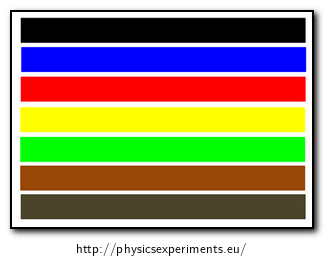Absorption of Radiation by Differently Coloured Surfaces
Experiment number : 4347
Goal of experiment
We will show that different colours of paper heat up differently when absorbing visible light and infrared radiation.
Theory
The interaction of bodies with electromagnetic radiation is affected mainly by the properties of the surfaces of these bodies – it is the structure of the surface that determines whether the incident radiation is absorbed by the material or not. Thus, for example, it has been observed that black clothing on a sunny day heats up more than a white T-shirt because it absorbs more radiation.
In our experiment we will replace the sun with a lamp with a light bulb and clothes with paper printed with differently coloured stripes. Our goal will be to see which coloured area warms up the most from the bulb. In doing so, it is important to remember that not only the impact of visible light but also the impact of infrared radiation contributes to the increase in surface temperature – as in the case of a sunny day. The heating that we observe is the result of these two influences working together.
Equipment
Thermal imaging camera, paper with stripes of different colours (see picture below), light bulb (in this experiment, we used a 40 W light bulb).

Procedure
Place the paper with coloured stripes on a table and let light from the light bulb hit the surface from a distance of tens of centimetres (see video in the following section). Then use a thermal imaging camera to observe how the temperature of the individual coloured stripes changes.
Sample result
A successful execution of the experiment is illustrated in the video below. It can be seen that only the two darkest shades heat up significantly, while the surfaces of the other colours show almost no temperature increase.
A thermal imaging camera FLIR i7 was used when making this video. The temperature range of the colour scheme was chosen in the interval 21 °C to 28 °C, the emissivity was ε = 0.95.
Technical notes
Warning! If you are going to print the stripes on the paper using an inkjet printer, do not do it right before demonstrating the experiment. Freshly printed paper is usually still wet with ink that will slowly evaporate and thus cool the coloured surface. This disturbing effect can then make the measurement invalid.
Pedagogical notes
From a physical point of view, it is actually misleading to talk about the fact that the surface of an object has a colour and therefore absorbs or reflects a given type of radiation. This idea should in fact be formulated rather the other way round – surfaces always absorb some part of the radiation and reflect some part, and it is the composition of the reflected visible radiation that gives rise to the sensation we call colour. Colour is therefore not the cause of the reflection/absorption of radiation, but its effect.
When creating the coloured stripes, it is advisable to place the dark, most heated stripes on the edges of the paper. If we place them in the middle, we run the risk of legitimate student reactions that these colours heat up the most simply because they are closest to the bulb. If we choose the arrangement as in the sample video, this reasoning cannot occur.
During the pilot testing of this task, it became apparent that visualization using a thermal imaging camera leads to one relatively common misinterpretation – namely, the idea that a coloured stripe behaves almost like a strip of metal, like a thermal conductor. In other words, the gradual heating of the stripe was imagined by some students as the conduction of heat through the stripe, not the gradual reception of energy by radiation. This misconception can be easily dispelled by shading one half of the length of the stripes with an obstacle (see video below).
If the stripes worked on the principle of heat conduction, the obstacle should not affect anything since it should not interfere with the conduction. However, since there is no heating of the stripes in the shielded region, we have thus demonstrated that the energy is transferred only by radiation.
Thermal imaging camera basics – link to PDF
In this experiment, a thermographic measurement is used. The theory of thermography and basic recommendation and procedures that can help you obtain more accurate and undistorted results can be found in Experiments with thermal imaging camera (in Czech only).







